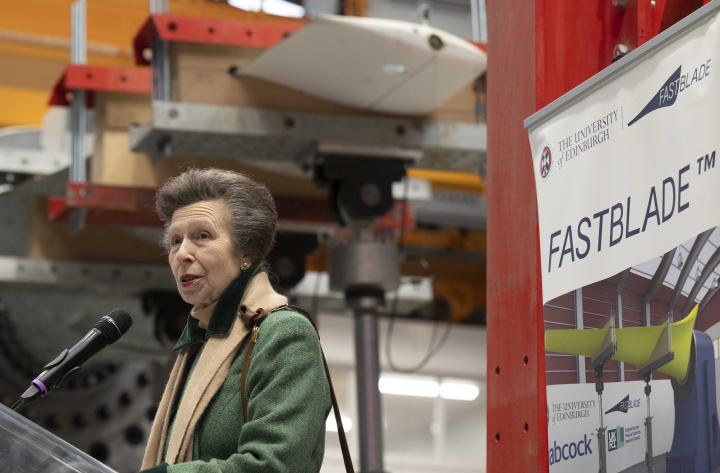Royal visit marks bid to develop world's largest tidal turbine blades
A project aiming to maximise tidal energy generation has been launched in the presence of Her Royal Highness, The Princess Royal, at the University’s FastBlade facility.

The Princess Royal, who is also Chancellor of the University, visited on Tuesday 17 January to meet colleagues from the testing facility and partners of the new MAXBlade project.
The €10 million project – funded by the European Union and UK Research and Innovation – aims to deliver a range of innovations to improve the performance of tidal turbines and reduce costs.
Blade manufacture
It will investigate the full lifecycle of tidal turbine blades, from materials, manufacture and operation, to decommissioning and recyclability. The project’s long-term aim is to ensure the European composite sector becomes the international leader in tidal blade manufacture.
The project plans to increase the area harnessed by Scottish tidal technology company Orbital Marine Power to generate power – known as the rotor swept area – by 70 percent, to more than 1,000 square metres.
MAXBlade will increase the length of the turbine blades from 10 to 13 metres – making them the longest of their kind in the world. The team says that boosting blade length will have the single greatest impact on reducing the cost of tidal energy.
Modelling by the University’s Institute of Energy Systems estimates £40bn could be generated for the UK economy by harnessing wave and tidal energy.
Collaborative project
The project, supported by the University’s commercialisation service, Edinburgh Innovations, will involve a two-year design and development phase, followed by an 18-month build.
During the build, the blades will undergo advanced structural testing at the FastBlade facility, a partnership between the University of Edinburgh and Babcock, based at the Arrol Gibb Innovation Campus at Babcock’s Rosyth facilities in Fife.
The technology will then undergo two years of real-world testing at the European Marine Energy Centre (EMEC) in Orkney. Two of Orbital Marine Power’s O2 floating platforms – the world’s most powerful tidal turbines – will each be fitted with four of the newly developed blades.
The team aims to generate 120,000 hours of performance data that will be assessed by EMEC and project partner TECNALIA, a research and technological development centre.
As the first large-scale project for FastBlade, MAXBlade is fantastic example of the capability generated when we combine cutting-edge university research with industry. EI is proud to have supported our academics and helped build and develop this partnership project, which can now help the world meet its sustainable energy challenge.
Turbine technology
Innovations from MAXBlade will be integrated with findings from its sister project, FORWARD2030, to enable large-scale production of Orbital’s O2 turbine technology.
This will pave the way to the tidal energy sector making significant contributions towards Europe’s energy systems, energy security and industrial development by 2030 and beyond to 2050, the team says.
Orbital is delighted to be involved with so many great partners on this truly cutting-edge project. MAXBlade will help deliver tidal energy into a future, low-carbon energy mix at lower costs while, at the same time, position UK & European businesses to benefit from long-term industrial opportunities that will come from this new, sustainable industry.
The University of Edinburgh is delighted to be a partner in the MAXBlade project, where we will demonstrate the unique rapid testing capability of the FastBlade facility. This will help the tidal energy industry to de-risk their ongoing turbine developments and provide low-cost, reliable renewable energy to the grid. We will also lead the development of thermoplastic resins in MAXBlade and the circular economy roadmap needed for future tidal blade manufacturing and recycling.
MAXBlade is led by TechnipFMC and includes Orbital Marine Power, Marasoft, TECNALIA, University of Edinburgh, EMEC, Laborelec and European Composites Industry Association.
Related links
Image credit: Neil Hanna

